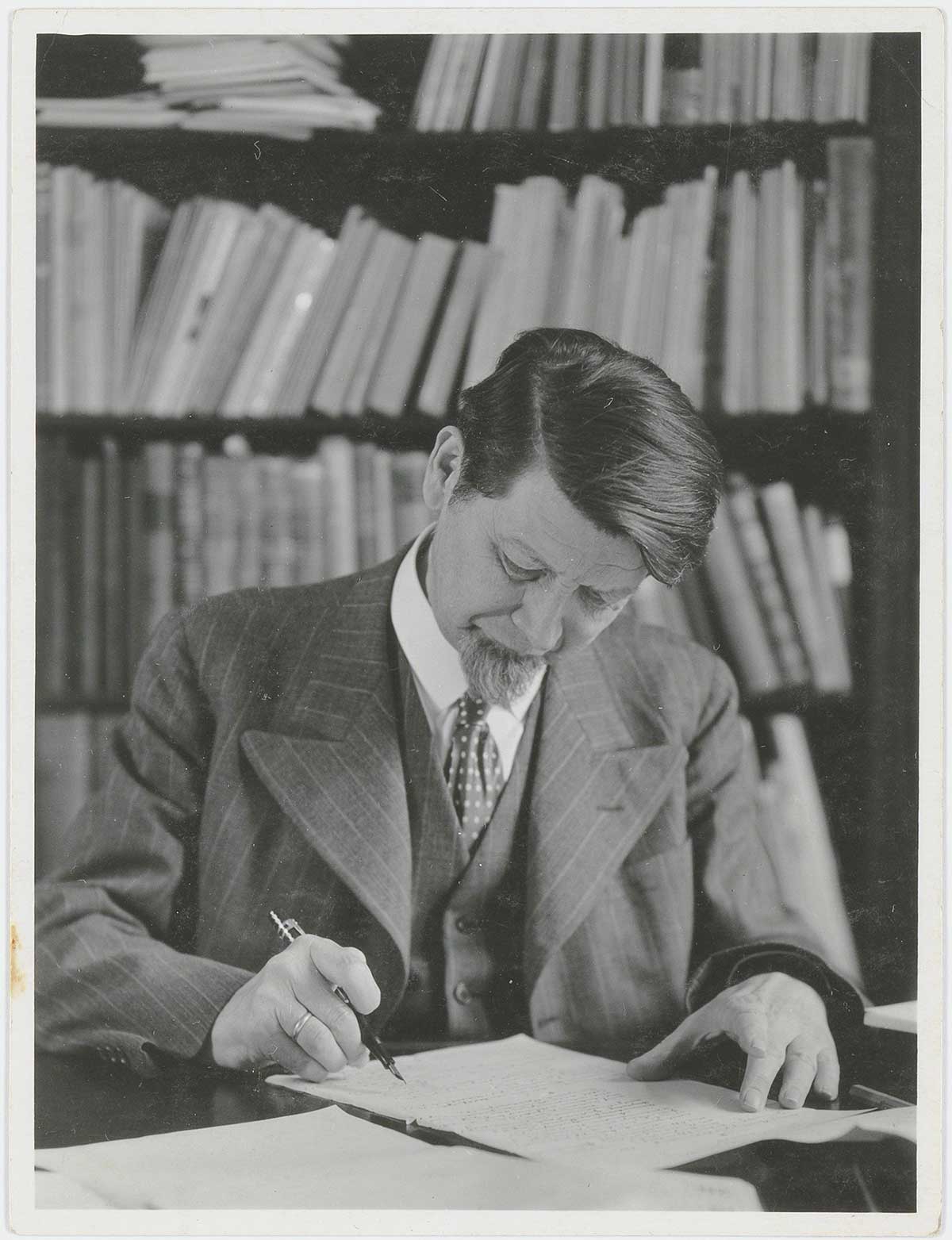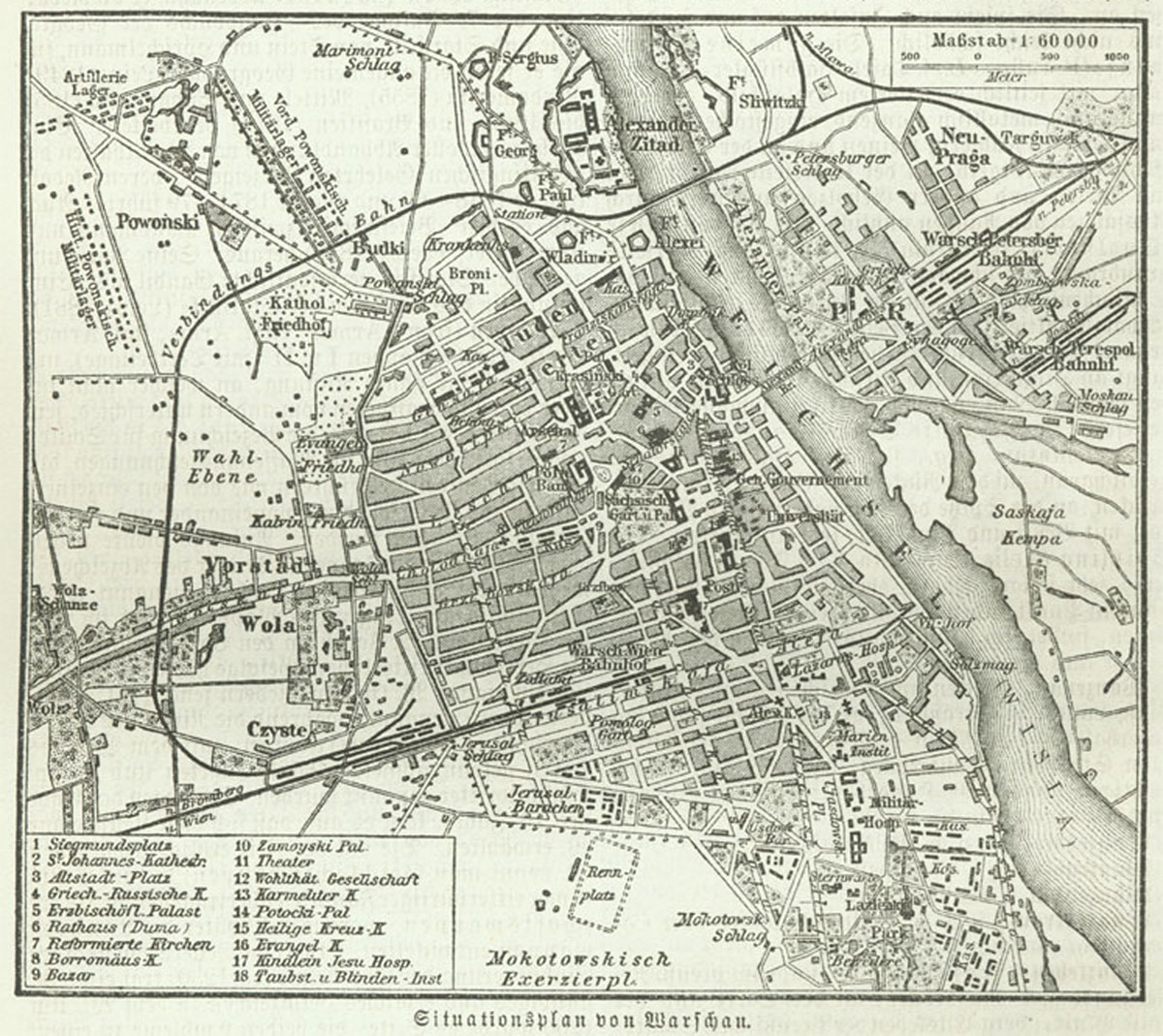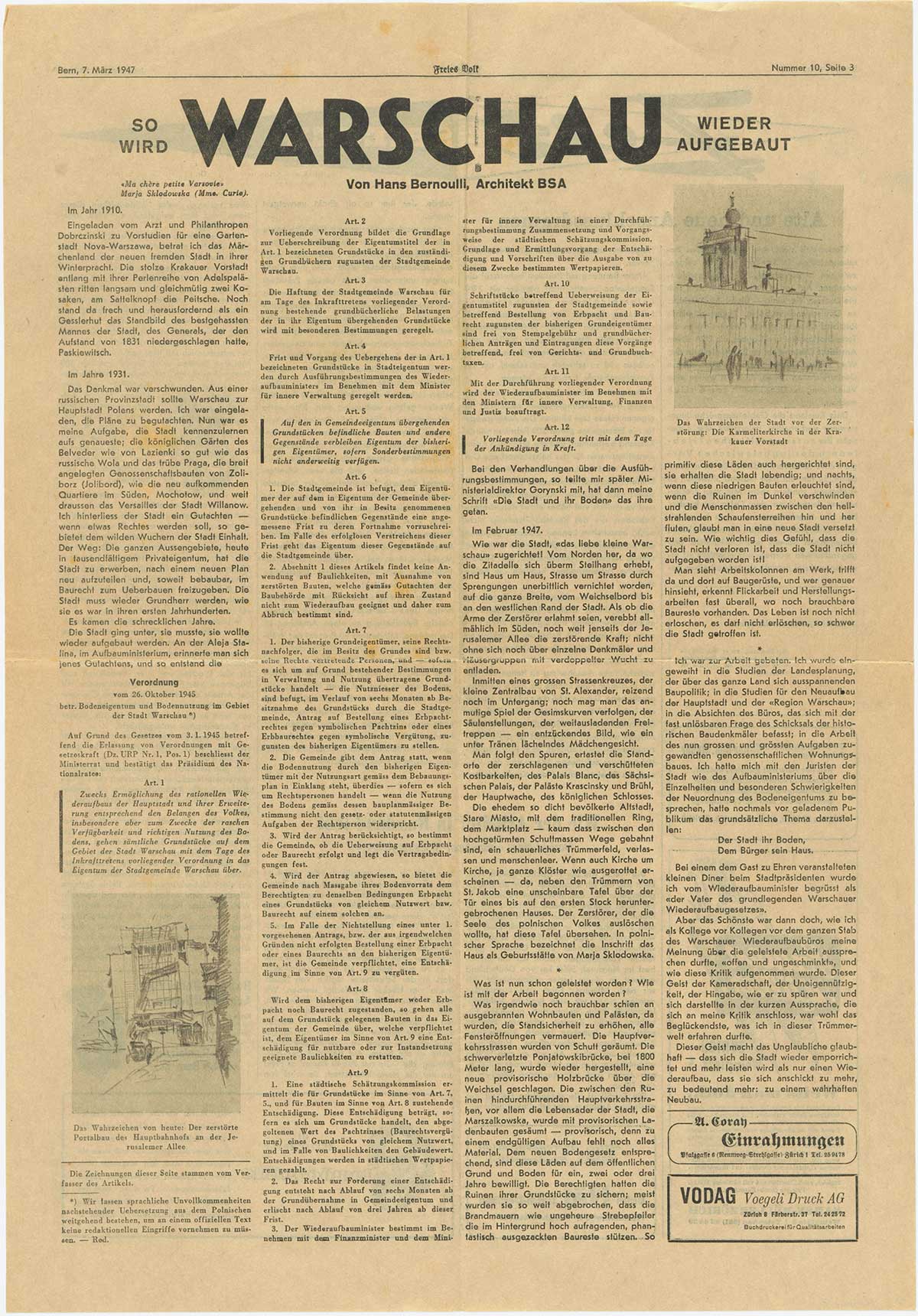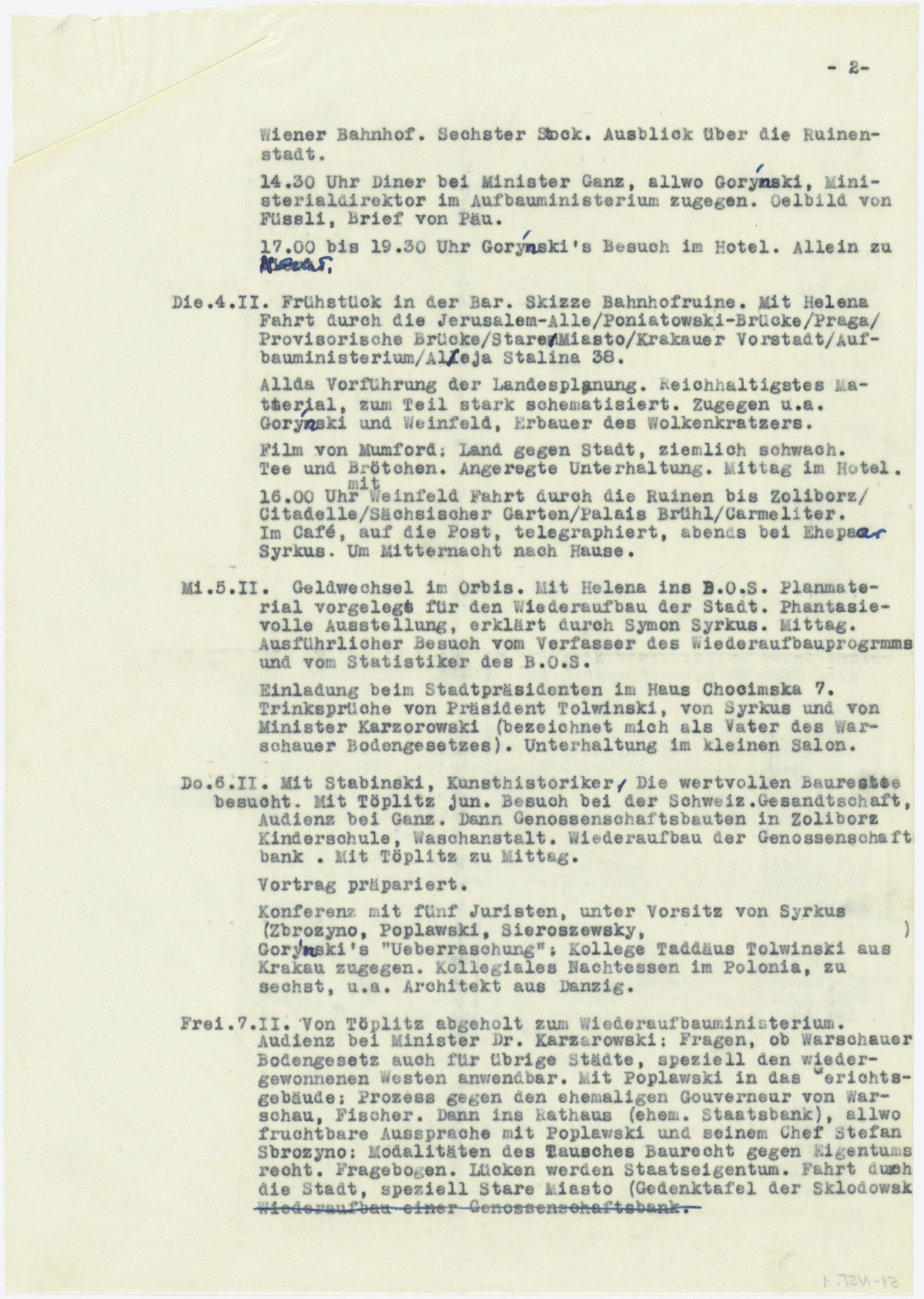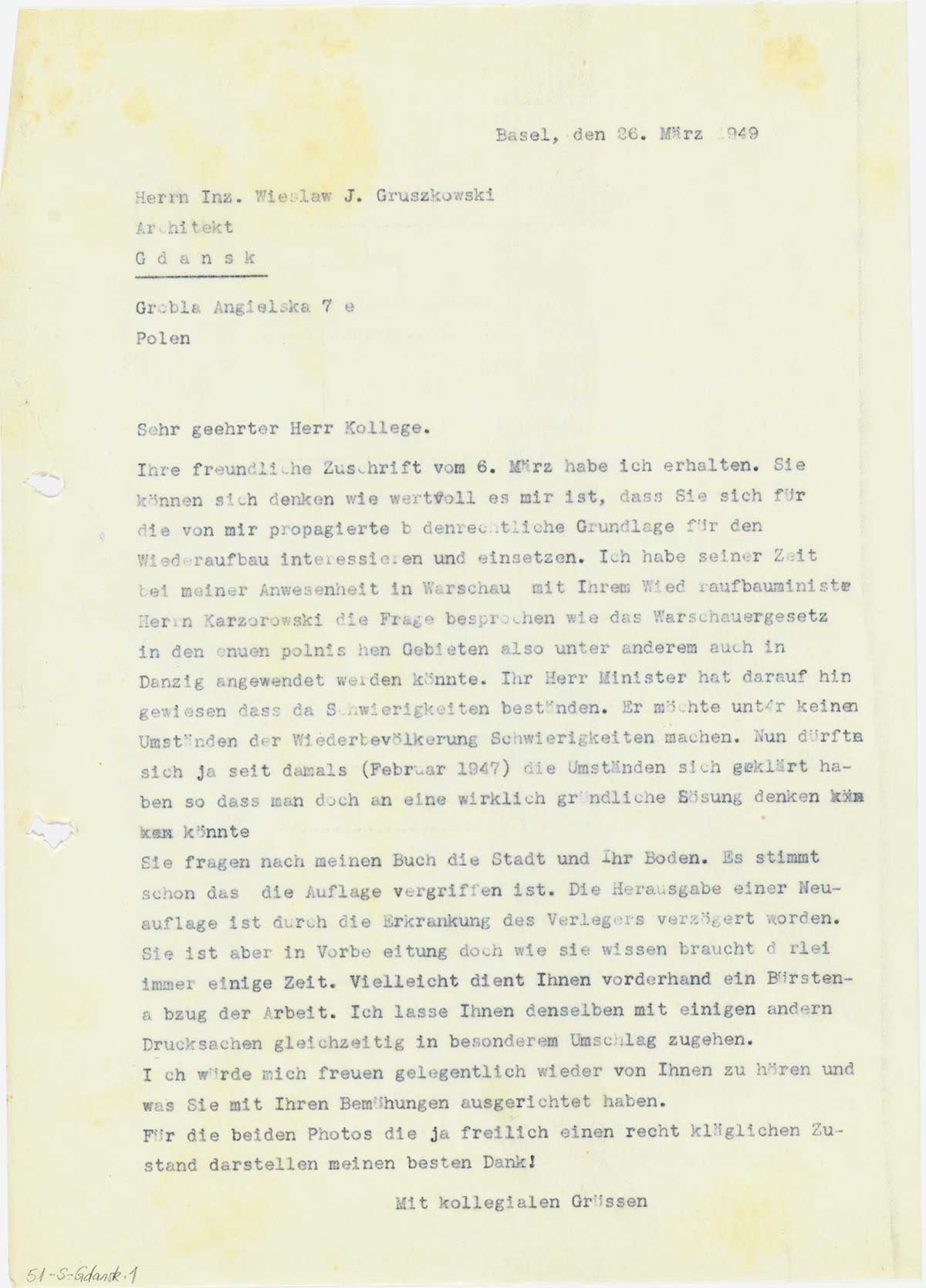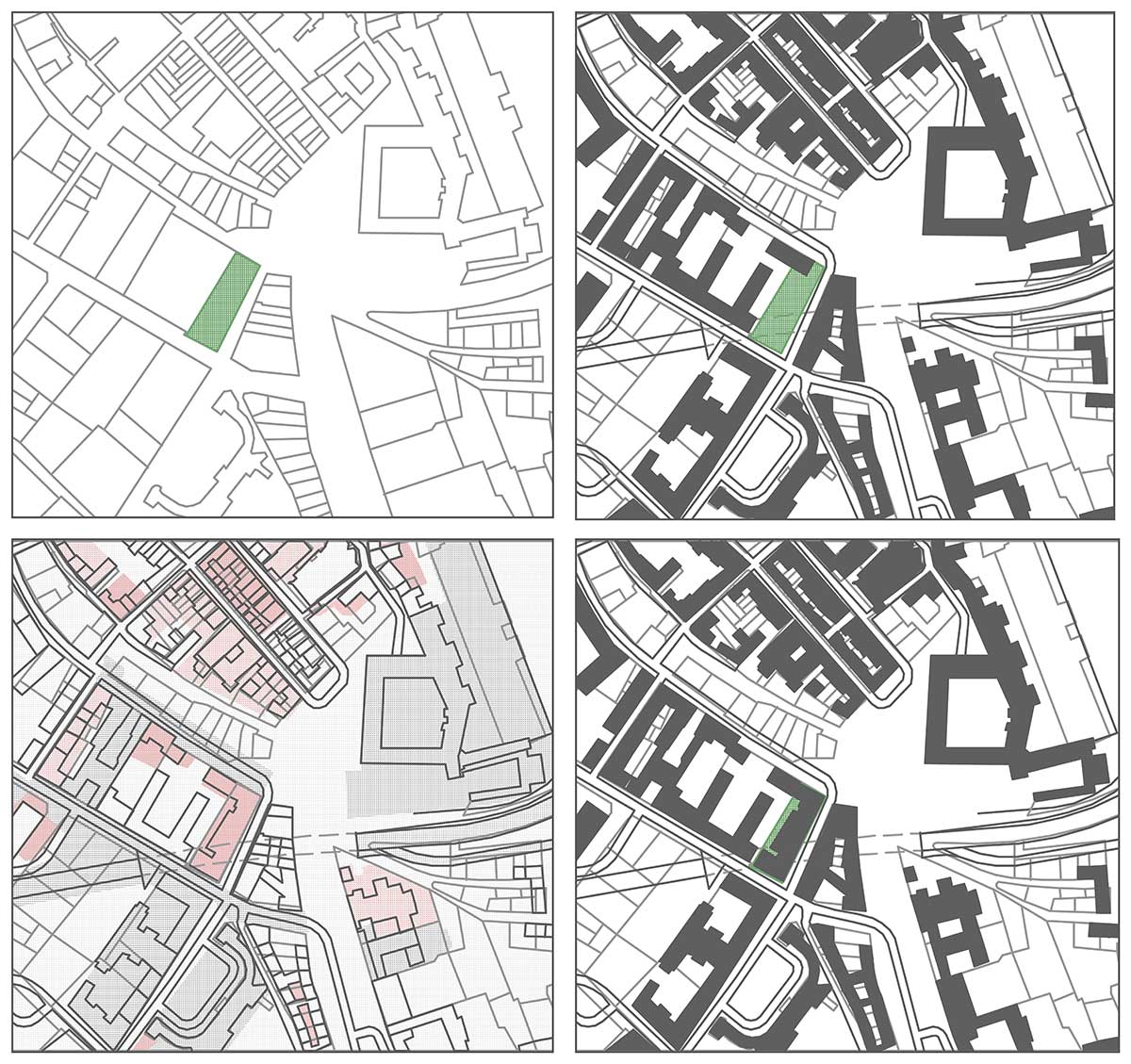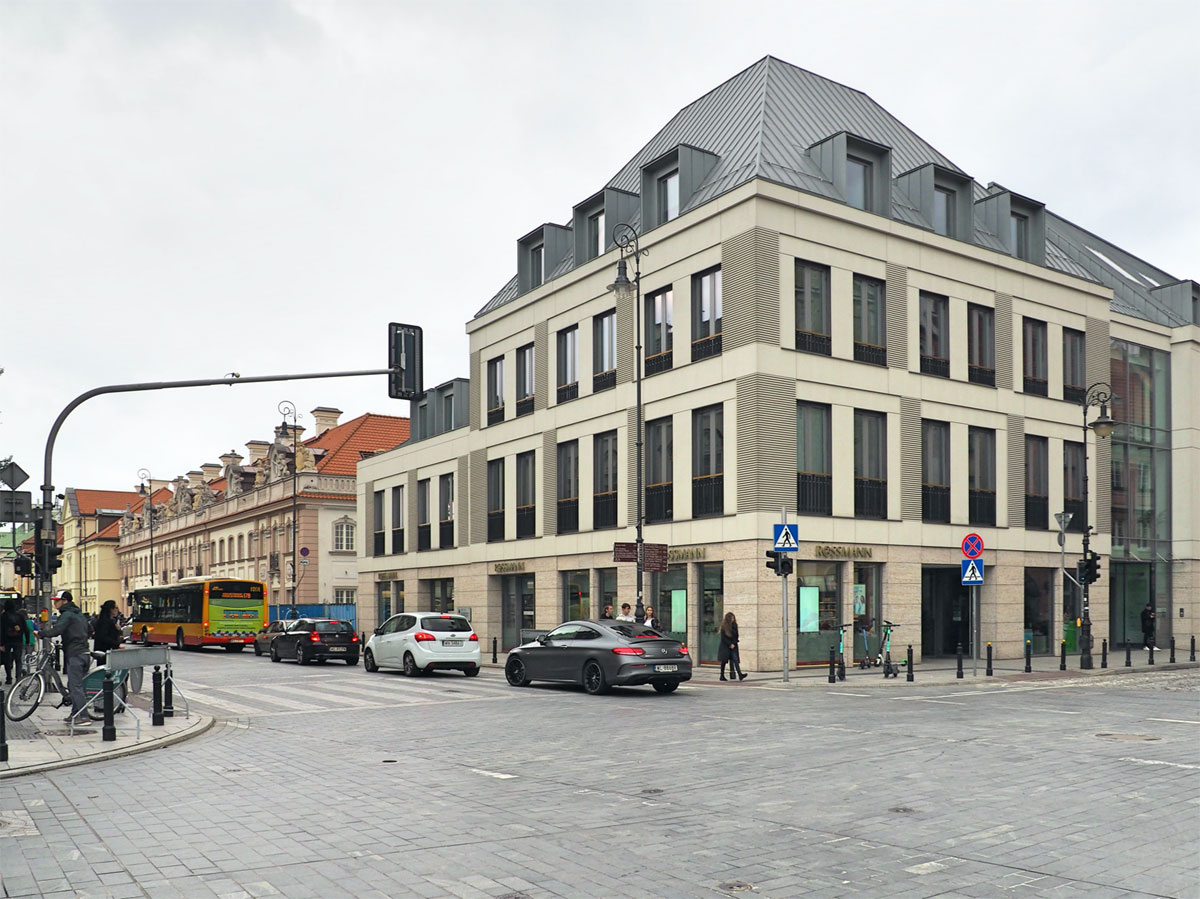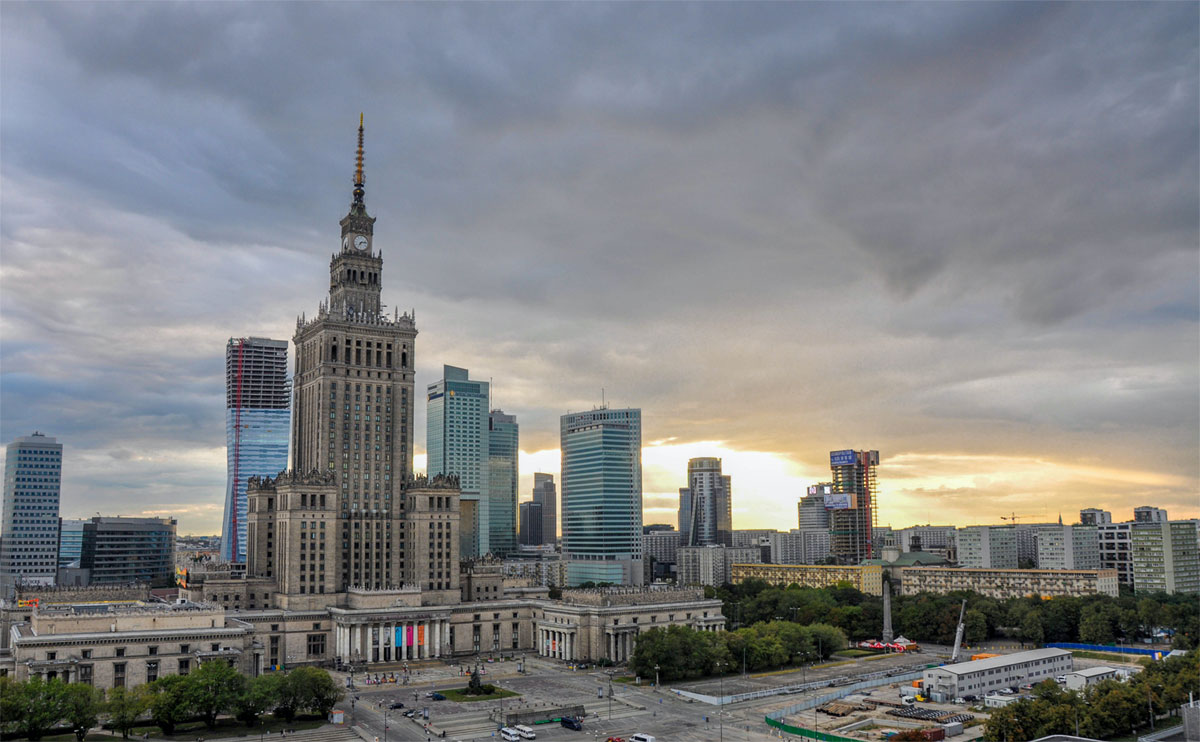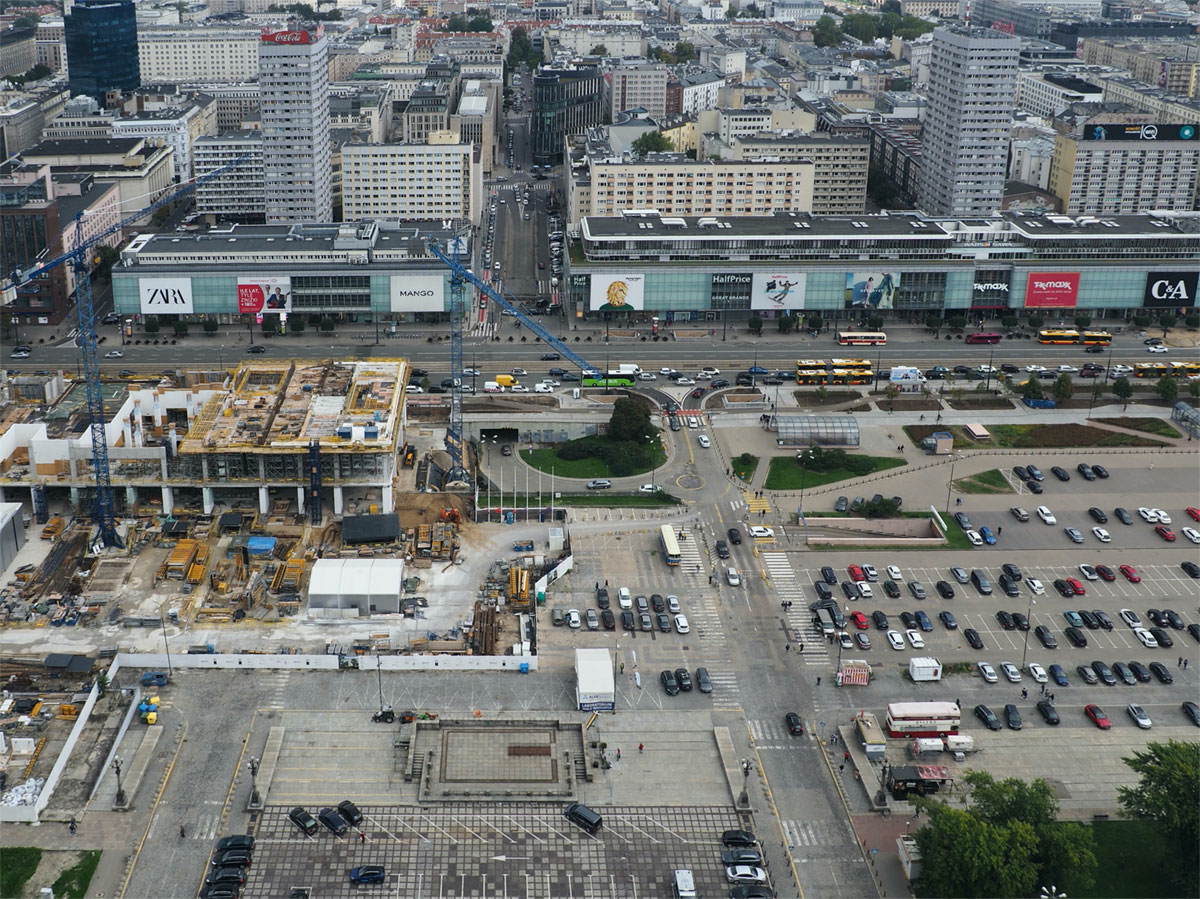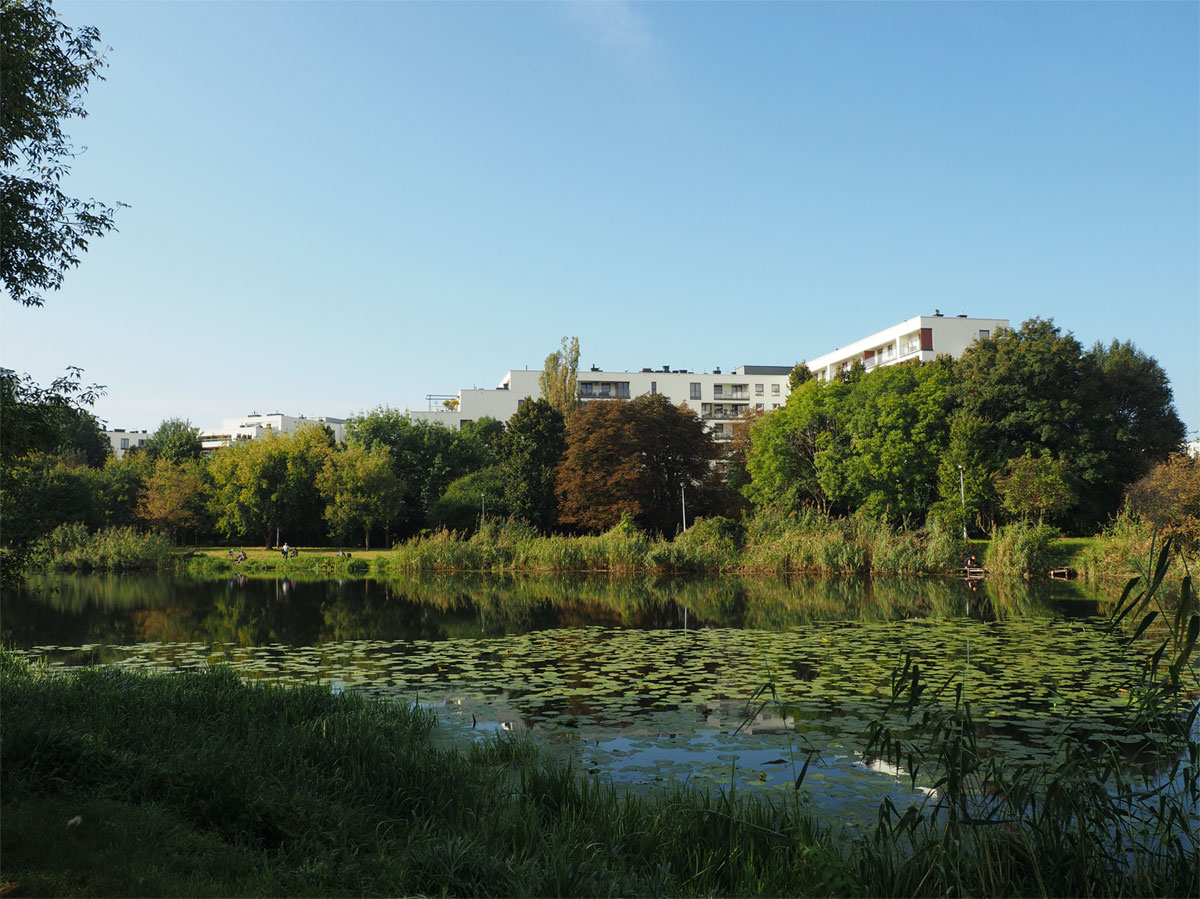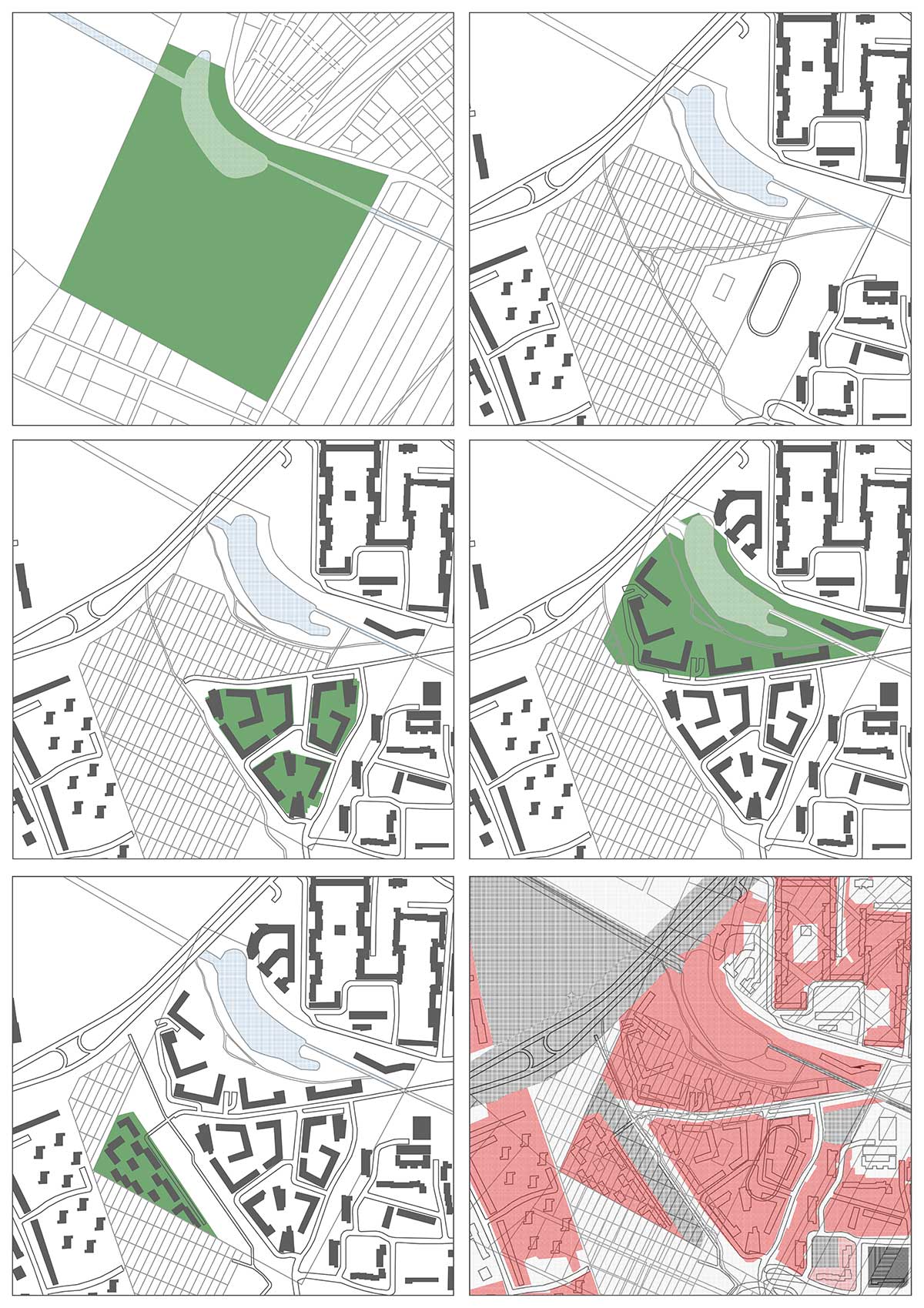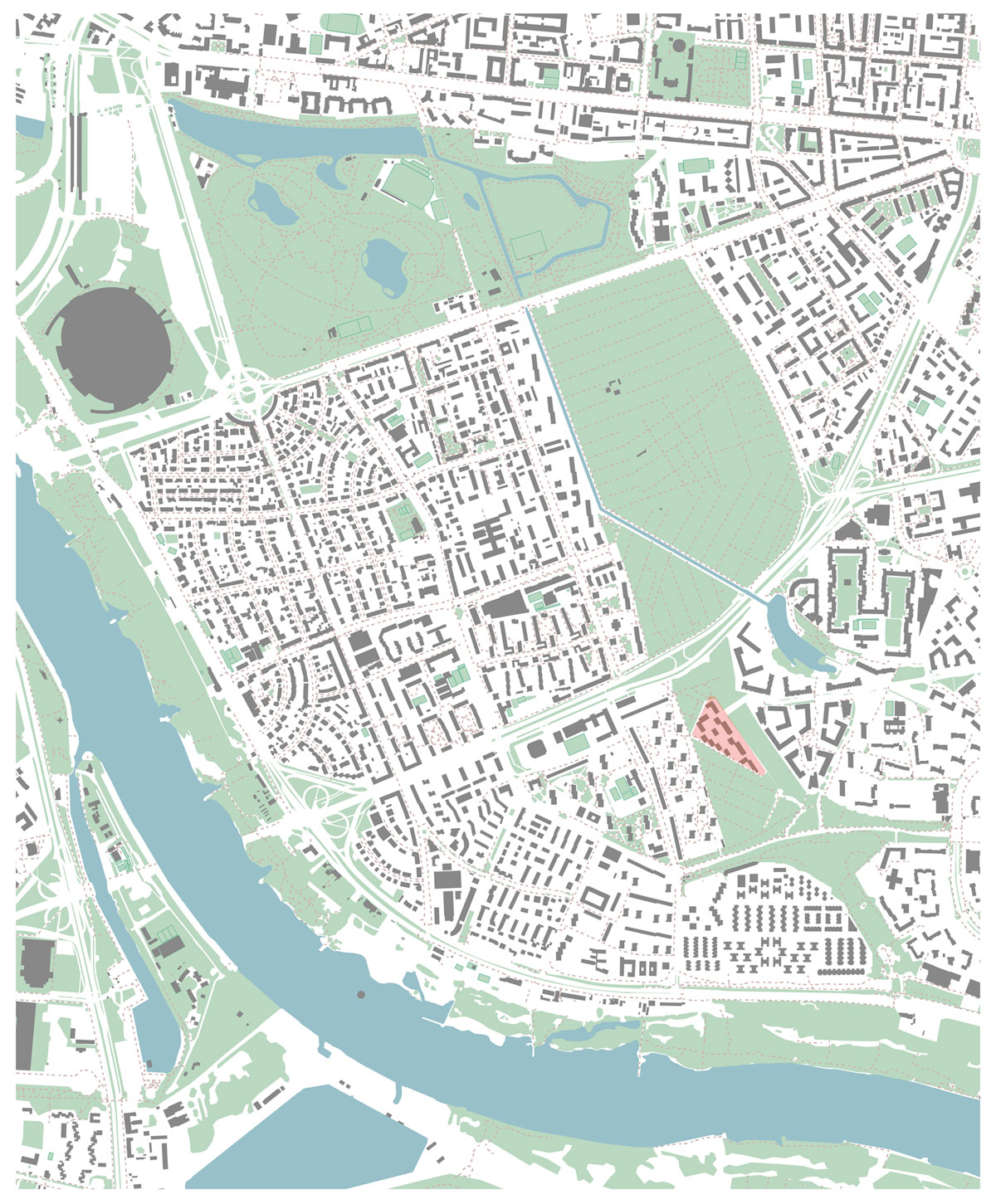Introduction
Studying the problems of urban development across various European cities at the beginning of the 20th century, Hans Bernoulli (Fig. 1), a Swiss architect and urban planner, famously argued that ‘there must be something wrong with the land and ground, and for some obscure reasons this embarrassment is not being taken care of’ (Bernoulli 1946: 6).1 These words refer to Warsaw, as well as to other European cities.
Bernoulli first visited Warsaw in 1910. Many urban development problems the city is facing today seem remarkably similar to those he identified over a century ago. The question of property rights on urban land is again the subject of heated political and academic debates in Warsaw (Fudala 2016)2 and across Europe (e.g., Hertweck 2020).3 Against this backdrop, the Varsovian debate on land gains importance beyond the local context, as it illustrates the long and controversial history of the European debate on urban land reforms. Due to the extended and uneven cycles of urban development, the outcomes of such reforms manifest themselves only in the long run. Therefore, this article traces the land reform debate in Warsaw since the city’s liberation from Russian rule in the aftermath of WWI till today. In doing that, we aim to place the most controversial Polish land policy act — the Bierut Decree (PKRN 1945), which enacted the communalization of land in Warsaw — in a long-term historical context.
Our main objective is thus to shed a different light on the contemporary debates on the reprivatization of urban land in Warsaw. So far, these debates have been strongly dominated by the opinion that the Polish communist government issued the Bierut Decree as a straight effect of Soviet influence (Shotter and Huber 2018; Majewski 2015; Pilawski 2014; Murawski 2019; Bazyler and Gostynski 2018; McNaughton 2018). Consequently, the decree is popularly perceived as a ‘Soviet crime against Varsovians’ (Popiołek-Roßkamp 2021: 164). It seems only natural to assume that the abolition of private property on urban land by the communist government in post-WWII Warsaw was inspired by the early Soviet land reform (Lenin 1917), which, in turn, had its ideological origins in the Communist Manifesto of 1848 (Marx and Engels 2007). It is inarguable that the implementation of the decree was mostly consistent with the communist ideology, but its theoretical origins lie elsewhere. As Małgorzata Popiołek-Roßkamp (2019) argues, based on archival evidence from Warsaw, the Bierut Decree was formulated under the strong influence of Bernoulli. Further evidence from the gta Archiv in Zürich firmly roots the Bierut Decree in the Western European land reform movements.
This change of perspective on the historical origins of the Bierut Decree is not simply a matter of historical accuracy. It means a shift in the whole perception of the ideological foundation of the decree: the spirit of the main Varsovian land law is not communist, but lies within the tradition of liberal socialism. Clarifying the origin of the decree becomes relevant for the contemporary political debate on reprivatization. It allows us to question multiple binary oppositions that characterize this ongoing debate: communism/capitalism, authoritarianism/democracy, and, most importantly, public/private property.
A significant body of academic literature and countless journalistic publications have addressed the Bierut Decree and the reprivatization of land in Warsaw since 1989. However, they mainly deal with legal or social aspects of this process (on legal aspects: Gdesz 2012; Białogłowski and Dybka 2014; Hetko 2012; Herman 2010; McNaughton 2018; Bazyler and Gostynski 2018; Kusiak 2019a; Kusiak 2019b; on social: Śpiewak 2017; Szpala and Zubik 2016; MJN 2017). The sociological study Chaos Warsaw (Kusiak 2017) provides an insightful account of the spatial consequences of the reprivatization in the city since 1989; however, it focuses mainly on practices of spatial governance, without addressing how these practices materialize in the urban space. So far, only one academic scholar has linked the communalization of land in Warsaw to the Western European land-reform movements (Popiołek-Roßkamp 2019; 2021).
This article is based on the study of various primary sources, including policy documents, newspaper articles, historical maps, field notes and correspondence from the bequest of Bernoulli preserved at the gta Archiv in Zürich. We seek to make three contributions. First, we provide further archival evidence on the origins of the Bierut Decree to support the claim by Popiołek-Roßkamp that the communalization of land in Warsaw is not rooted exclusively in the Soviet communist ideology. Second, taking the development of several reprivatized land plots in Warsaw as examples, we illustrate how the obscure reprivatization practices have, over the past three decades, reintroduced the paradigmatic problems of urban development that Bernoulli described in 1946 in his book Towns and the Land. Third, we discuss reprivatization from the perspective of economic value production and argue that the communalization of land in post-WWII Warsaw was a unique urban policy achievement with a few analogs in the European context.4
Post-WWII Land Reform in Warsaw: The Bierut Decree
Warsaw after WWII was a severely damaged cityscape: estimations about the scale of its destruction range between 85% (in early propaganda publications, see Popiołek-Roßkamp 2021: 159) and 67% (UMSW 2004: 60). The municipality was faced with too many challenges, including legal obstacles, to begin the reconstruction of the city immediately after the war. Even removing rubble from a site required the property owner’s consent, but many pre-war owners could not be located by the authorities. At the same time, the vast housing crisis required quick action to provide the city’s remaining inhabitants with some form of shelter. Under these circumstances, some limitations on property rights were unavoidable (Kusiak 2019a: 652).
In response, the new communist government of the People’s Republic of Poland issued the Decree of 26 October 1945, commonly known as the Bierut Decree. Named after the president of the Republic, Bolesław Bierut, it transferred the property rights regarding all land within the 1939 borders of the city to the municipal authorities. Buildings, as well as other land improvements situated on the plot, were to remain in the property of their former owners unless special regulations required otherwise. The decree was the only legislation in Polish law that separated ownership of land from ownership of buildings (Kusiak 2017: 177). Within six months, former property owners and their legal successors were entitled (for a symbolic fee) to apply for a long-term lease of the plot or the right to build on it. However, lease agreements and building rights were granted only if a plot’s dimensions, location, and function complied with the general plan of development of the area (PKRN 1945: Art. 7).
If the municipality refused the request for a lease or the right to build, it had to offer the applicant a long-term lease of another plot of equal economic value or the right to build on such a plot. The municipality was obliged to pay compensation if the former owner had not applied for a lease or the right to build, as described above. The compensation had to be paid in city bonds equal to the capitalized value of the rent for the plot or the right to build there. The time to apply for such compensation was limited to three years (PKRN 1945: Art. 9). In practice, however, almost all compensation claims were ignored or rejected (Davies 2017; Bazyler and Gostynski 2018: 235). After 1989, these rejected compensation claims became the legal basis for the reprivatization process, which will be addressed below.
The Bierut Decree thus communalized all urban land with immediate effect, placing it at the disposal of municipal authorities. This land reform is often perceived as a direct consequence of the shift towards communist ideology (e.g., Shotter and Huber 2018; Majewski 2015; Pilawski 2014; Bazyler and Gostynski 2018; McNaughton 2018). Although this is often presented as a self-evident fact (especially Murawski 2019: 18, 45, 66), upon closer look the legal framing of the decree is entirely different from that of the Soviet Decree on Land of 26 October 1917 (Lenin 1917). Because the Bierut Decree separates private ownership of land from the ownership of buildings, it preserves the latter while substituting the former with a long-term lease. This was not the case in the Soviet Union, where both were completely abolished in line with the Communist Manifesto of 1848 (Marx and Engels 2007). Furthermore, the right to apply for compensation, either in the form of an alternative plot of land or its monetary equivalent, granted by the Polish decree, was completely absent in its counterpart in the USSR. To understand the reason for these differences, it is essential to look into the origins of the Bierut Decree from the perspective of urban history.
Interwar Origins of the Land Reform
When the Second Polish Republic was established in 1918, and Warsaw was no longer under Russian rule, rapid industrialization was accompanied by an urgent need for new urban plans regulating the city’s development and addressing major issues of the time: a housing shortage, overcrowding, poor sanitary conditions, a lack of green space, a scarcity of communal facilities and a congested street network (Malisz 1987: 258). These issues were common in most European cities of that time (Franz and Meier 2011: 14). However, in Warsaw, the situation was particularly desperate, as tsarist Russian authorities had refused to expand the city’s border (Fig. 2), although the urban population expanded from 260,000 in 1870 to 885,000 in 1914, more than 3.4 times the size in 1870 (Popiołek-Roßkamp 2021: 56).
Plan of Warsaw around 1880, as presented in Meyers Konversationslexikon (1880: 400). © CC BY 2.0.
The development of new urban plans — and especially the search for possibilities to realize them — brought about significant challenges for the interwar urban planners. To address these challenges, Bernoulli, one of the most prominent urban planners of the time, was invited to Warsaw to give an expert opinion. On 23 January 1931, he gave a lecture in Warsaw promoting the communalization of land as the only option:
We can look at the issue from one side or another, but there is only one possible and clear solution: the municipality should own the whole territory of the city as inalienable property. New urban plans can be laid over this undivided property without any concern for property boundaries … The city will then allocate the land by parcel, by block or by quarter to those who want to build on it for a long period of sixty or hundred years; by doing so, the municipality preserves the right to decide over the territory when this time is over … This is the principle that [Ebenezer] Howard applied in his Garden City.5 (Bernoulli 1931)
This position of Bernoulli is reminiscent of the closing statements of the Athens Charter of 1933 that lamented the fragmented state of urban land ownership and demanded that private interests be subordinated to the interests of the collective (first published in 1943; see Le Corbusier 1975: 138). Its uncompromising tone is attributed to Le Corbusier’s heavy revisions of the original drafts (Gold 1998: 243–244). However, the original statements of the CIAM IV meeting, ‘Constatations’ (Conclusions), had already included clauses on the crucial role of land and the demand to prioritize public interests (CIAM 1933). Importantly, the land issue was vigorously debated. According to Siegfried Giedion, the term expropriation caused too much political dispute among the members of the CIAM congress and had to be replaced with a more ‘value-free’ formulation. Consequently, the concrete demands for ‘expropriation’ (Zürich version) and ‘mobilization’ (Paris version) of land were omitted in the final version of the document. Taking into account the various political systems of the participating countries, the closing paragraph of the ‘Constatations’ urges regulating the provision of land (‘régler la disposition du sol’) to avoid its fragmentation and calls it the most serious issue of the time (Steinmann 1979: 148–149, 158–159).
This idea of undivided urban land was implemented in the project Warszawa Funkcjonalna (Functional Warsaw) by Jan Chmielewski and Szymon Syrkus (the chairman of the Polish delegation at CIAM IV), and further discussed with Bernoulli during the 1934 CIAM working meeting at ETH Zürich (Chmielewski and Syrkus 2003). This project significantly shaped the Polish urban planning practice and can be regarded as the most prominent example of progressive urban planning in Poland of that time. However, at the moment of its conception, the realization of such a plan was not possible because local authorities owned only 4% of urban land (Malisz 1987: 259). To address this issue, in 1935, the mayor of Warsaw, Stefan Starzyński, initiated the ‘Land Campaign’ that compelled private land owners to donate land to the municipality. By the end of the interwar period, this initiative managed to increase the amount of land owned by the municipality to 8% (Kusiak 2019a: 652; see Piątek 2016).
Plans to communalize urban land in Warsaw were hence already developed and partially implemented in the interwar period, at least 15 years prior to the Bierut Decree. Moreover, the interwar debate in Warsaw was embedded in the larger European debates on land. The position of Bernoulli is far from that of the Swiss CIAM group. It is, however, close in spirit to the relevant articles of the Weimar Constitution of 1919 and the Constitution of the Free State of Bavaria of 1946, which express the need to socialize any increases in economic value of urban land resulting from the development of the city and to use them for public benefit; it is also related to the debates about the Federal Building Act reform in West Germany in the early 1970s (see Vogel 2019: 17–22).
Reconstruction of Poland after WWII
In the post-WWII years, Bernoulli was involved as a consultant for the reconstruction of many European cities, including Freiburg, Budapest, Prague, and Vienna. To enable the realization of large-scale reconstruction plans, he argued for the limitation of private property on urban land and maintaining the private property on buildings. Importantly, Bernoulli grounded his ideas in the intellectual legacy of Silvio Gesell’s (1919) liberal socialist Free-Land, Free-Money theory and argued against radical expropriation of land as outlined in the Communist Manifesto. Consequently, Bernoulli proposed a much more moderate way to communalize urban land based on the immediate compensation of former owners (1946: 97–107). However, only in socialist Warsaw could his main idea — separating ownership of land from the ownership of buildings — be legally implemented.
After the intentional destruction of Warsaw during WWII, rebuilding the city became the subject of vigorous debates among Polish and international experts. In 1946, various experts invited by the Office for the Reconstruction of the Capital (Biuro Odbudowy Stolicy), including, in addition to Bernoulli, Tadeusz Tołwiński, Sergey Chernyshev, Hans Schmidt, and André Lurçat, were asked to review the reconstruction plan developed by the office’s urban planning department (Popiołek-Roßkamp 2019: 160–163). Although the initial plan was not approved, it laid the foundation for further reconstruction plans. The urgent need for fast large-scale reconstruction offered the socialist government of Poland the chance to implement the land reform that had been envisioned already in the interwar period. According to Juliusz Goryński, director of the Department of Building Policy for Poland’s Ministry of Reconstruction, Bernoulli’s Towns and the Land significantly affected the negotiations of legal regulations for the communalization of land (quoted in Bernoulli 1947b) (Fig. 3). Moreover, the minister of reconstruction, Michał Kaczorowski, in a speech given during Bernoulli’s visit to Warsaw in February 1947, addressed him as ‘the father of the fundamental Varsovian reconstruction law’ (Bernoulli 1947a) (Fig. 4).
‘So wird Warschau wieder aufgebaut’, an article by Hans Bernoulli in the Basel newspaper Freies Volk (1947b). © gta Archiv / ETH Zürich, Bernoulli.
Not only did Bernoulli inspire the Bierut Decree, he also advised the municipality of Warsaw on many occasions in the course of the decree’s implementation, according to records preserved in gta Archiv (Bernoulli bequest, 51-S-Wiederaufbau/Warschau). This advisory activity was well known within the professional community in Poland, as the following case around the reconstruction of Gdańsk illustrates. An architect involved in that city’s reconstruction, Wiesław Gruszkowski (1949), complained in a letter to Bernoulli that the municipal authorities did not pass a land reform act similar to that of Warsaw, even though Gdańsk would be a perfect case for the application of Bernoulli’s theory (Fig. 5). Bernoulli (1949) responded that he had brought up the matter to Minister Kaczorowski in Warsaw, who viewed the implementation of the Varsovian land reform in Gdańsk and other newly recovered territories as problematic, because it could hinder their repopulation.
Further evidence of Bernoulli’s influence on the municipal authorities of Warsaw is visible in his correspondence with Emanuel Buchwalter, a property owner from Warsaw residing in Bern, Switzerland. During his visit to Warsaw in 1947, Bernoulli used his contacts among the high-ranking municipality lawyers to file a property claim on behalf of Buchwalter directly to the head of the Land Management Department of Warsaw, Stefan Zbrożyna. Furthermore, Bernoulli (1947c) advised Buchwalter on further proceedings and offered him support in getting legal assistance for his case through Marcin Weinfeld, the architect of the famous interwar skyscraper Prudential in Warsaw. Even though Bernoulli’s ideas largely remained on paper, he clearly exerted considerable influence in post-WWII Poland, further support for the argument that the Bierut Decree was shaped by his theoretical work.
Reprivatization of Urban Land in Warsaw after 1989
How does this historical evidence change the perspective on the post-socialist reprivatization debate? After the foundation of the Third Polish Republic, the post-socialist transition began. The shift from a planned economy towards the capitalist ‘free market’, founded on inviolable private property rights, directly affected the management of space. The centralized socialist spatial planning system was deregulated through a set of legal reforms, initiated by the Act on Local Self-Government (DU 1990) and the Act on Spatial Development (DU 1994), which abandoned the compulsive design of spatial plans and passed the authority for spatial development to communes (see Dutkowski 2007). Furthermore, the Act on Spatial Planning and Development (DU 2003) enabled the issuing of building permits for an area even in the absence of general spatial plans, thus further deregulating urban planning as a profession.
As happened in other post-socialist states, the massive privatization of state assets was part of the response to the loan conditions dictated by the World Bank and the IMF. However, in Poland, a fierce political debate paralleled the restitution and privatization of former state properties. The complicated urban history of Poland is probably the reason for the ongoing debate on property restitution, which other post-socialist states had accomplished within a few years, as Johanna Kusiak argues. Although over 25 attempts have been made to regulate this process, up until recently, no all-encompassing reprivatization law has been passed due to various political and economic reasons, including colossal compensation costs, political issues of social justice, class interests of the majority, and fears about restitution claims from abroad (Kusiak 2019a: 654).
Over the past three decades, the absence of reprivatization legislation left the responsibility for determining the direction and scale of the reprivatization process up to individual court hearings. From 1989 until 2011, only heirs of single-family houses or of plots of land for the construction of such houses were entitled to make claims for reprivatization or compensation. In 2011, the Constitutional Court of Poland enlarged the right of reprivatization claims by including other kinds of property, e.g., land occupied by post-WWII tenement houses. This amendment caused a significant increase in compensation claims. By 2011, the total cost of property claimed amounted to an astronomical sum of 40 billion Polish złotych — around €9 billion (Górczynska 2016: 372).
The absence of general plans for spatial development, coupled with the largely unregulated process of reprivatization, created vast possibilities for speculative urban developments. Without all-encompassing reprivatization legislation, every case had to be considered individually. During the main phase of the reprivatization process (2007–2016), restitution claims on 447 properties, consisting of 4,479 occupied dwellings, were satisfied. These claims were based on the pre-war property grid and often had very little to do with the built fabric of the reconstructed city. In consequence, many plots used as public spaces were claimed for reprivatization (Davies 2017).
On 11 August 2021, the Polish parliament passed an amendment to finally resolve the situation by setting a 30-year limit on all legal challenges to restitution claims. This decision led to yet another political conflict: the Israeli foreign minister, Jair Lapid, accused the Polish government of issuing a law that ‘borders on Holocaust denial’ (Wanat 2021). Since nearly all beneficiaries of the post-WWII reprivatization are Polish citizens, this claim reflects the state of diplomatic affairs between Poland and Israel, rather than the content of the policy amendment (MJN 2021). Nonetheless, it is indicative that the unresolved status of unclaimed Jewish properties, largely ignored during the post-WWII reconstruction (Popiołek-Roßkamp 2021: 182, 338), has returned to haunt today’s Warsaw. Although the amendment of 2021 significantly limits new reprivatization claims based on the Bierut Decree, it by no means puts an end to the reprivatization process in general. The status of many plots already subjected to reprivatization claims thus remains unclear and judicial litigations continue (MJN 2021).
Let us now look at the practice in greater detail. The four prominent case studies discussed are widely known due to the journalist and activist work that placed them in the center of public attention. The popular newspaper Wyborcza, for instance, has a whole section dedicated to reprivatization in Warsaw.6 These examples illustrate how the paradigmatic urban development problems discussed by Bernoulli in Towns and the Land re-emerge in Warsaw because of reprivatization. A direct comparison between the situation in interwar and today’s Warsaw cannot be drawn. Despite a large number of reprivatized properties, the cityscape is still dominated by the socialist urban fabric. However, it is indicative that the urban land issues that led to the debate on the reforms and the consequent establishment of urban planning as a profession in the 1920s are, again, present in Warsaw. These issues include a fragmented parceling of land, causing random construction of buildings, land speculation determining building design, and private property on land hindering the realization of projects for public benefit.
Case 1: Business with Heritage on Plac Zamkowy
A notorious reprivatization case that illustrates the complex relationship between heritage and private property in today’s Warsaw can be seen on Plac Zamkowy (Castle square) in the reconstructed part of the Old Town (Fig. 6). The plot of around 2,100 sq. m is located between Podwale, Senatorska, and Miodowa streets and was reprivatized in January 2011 by Maciej Marcinkowski, a private investor specializing in trade with reprivatization claims. Several months later, he passed the property to Senatorska Investment, a private investment company run by his son, Maksymilian Marcinkowski (Urzykowski 2013). They commissioned German architectural office RKW+ to design a new building containing 3,800 sq. m of office space, and 1,600 sq. m of retail and service space (Fig. 7). Less than a year later, in 2012, the Municipal Government Office issued a building permit for the new building with the telling name of Business with Heritage (SSMKDN 2014).
Although this plot is situated outside the boundaries of the city’s World Heritage Property, which was included in the UNESCO World Heritage List in 1980, they share a boundary. In 1978, the nomination of the reconstructed Old Town of Warsaw caused a debate among the members of the World Heritage Committee about whether the site met the authenticity criterion to be placed on the List (Cameron 2008). Nevertheless, the International Council on Monuments and Sites (ICOMOS 1980) advised the World Heritage Committee to include Warsaw based on the following definition of authenticity:
The reconstruction of the historic center so that it is identical with the original, symbolizes the will to ensure the survival of one of the prime settings of Polish culture and illustrates, in exemplary fashion, the efficiency of the restoration techniques of the second half of the 20th century. … Given these facts, the criterion of authenticity cannot be applied in its strict sense. The historic center of Warsaw, tragically destroyed in 1944, is an exceptional example of the global reconstruction of a sequence of history running from 13th to 20th century. Its authenticity is associated with its unique realization of the years 1945 to 1966.
The ICOMOS evaluation report thus states that the ‘Outstanding Universal Value’ of the Old Town lies in its unique full-scale reconstruction, symbolizing the will of the post-war Polish citizens to preserve their national culture.
Development and ownership timeline of the area around Plac Zamkowy, 1936–2021. Left to right, top to bottom: 1936: Land-property grid around Plac Zamkowy, case-study plot marked in green; 2011: Figure plan of the area at the moment of reprivatization, the transit tunnel underneath the plot; 2021: Property structure: red = belongs to private investors; dark grey = belongs to the state; light grey = belongs to the city; 2021: Business with Heritage building occupies the whole plot. Drawn in AutoCAD and Adobe Illustrator by Alicja Willam and Dasha Kuletskaya, based on CWOSC 2021 2021 © CC BY 2.0.
In 2013, the director of the UNESCO World Heritage Center, Kishore Rau, expressed concerns in his official letter to Polish authorities relating to the construction of the new commercial building on the aforementioned plot, which may endanger this ‘Outstanding Universal Value’. Alarmed by the possible negative outcomes for the whole city, the mayor of Warsaw, Hanna Beata Gronkiewicz-Waltz, decided to suspend the construction and to reopen the building permit procedure (SSMKDN 2014). However, a higher legal instance, Mazovian Voivode, cancelled this decision. Consequently, the ICOMOS advisory mission was sent to Warsaw in December 2013 to evaluate the situation. As a result, the UNESCO World Heritage Committee proposed to examine the possibility of creating a buffer zone around the World Heritage Property to prevent future interventions of a similar kind (SSMKDN 2014).
Following the recommendations by the ICOMOS advisory missions, the commercial building was subject to minor adjustments, including slight changes in the color and material of the roof and the façade, and lowering of the roof ridges by 30 cm in one part of the building. Further adjustments recommended by UNESCO were rejected by the president of Senatorska Investment, with the justification that they would violate the building permit issued by the municipality and that the building had already reached an advanced state of execution (SSMKDN 2015). Thus, construction continued, and the building was finished in 2015.
Another issue regarding the reprivatization case on Plac Zamkowy concerned the tunnel of the west–east transit route, a major post-WWII infrastructure project, partly situated below the plot. There is no legal concept in Poland that separates land ownership on different spatial levels. In 2011, as the plot on Plac Zamkowy was reprivatized, one third of the tunnel constructed with public money legally became private property (Śpiewak 2017). The new owners granted the municipality usage rights for their part of the tunnel.
This example illustrates how reprivatization enables speculative real estate development to extract maximum profit at the expense of the whole city and has the potential to hinder public infrastructure. In the case of Business with Heritage, the encroaching of private speculative interests upon public interests is particularly manifest: the economic value of the plot and, therefore, its speculative potential arise primarily from its location in the Old Town. The heritage status of this district — its Outstanding Universal Value — and its location in the heart of the contemporary prosperous city are the main contributors to its economic value. As the ICOMOS report of 1980 cited above states, this value was largely created by the post-war population of the city. The reprivatization in this case not only captured the economic value that was created by others (produced also through transformation of cultural and heritage values; see especially Boltanski and Esquerre 2020), but it also created a disvalue, both in cultural and economic terms, for the rest of the city. The notion of reprivatization as robbery (Kusiak 2019a) seems particularly appropriate in this context.
Case 2: Plac Defilad
Other prominent examples of reprivatization are located around the Palace of Culture and Science, one of Warsaw’s most prominent buildings, on Plac Defilad (Parade square). Before WWII, this territory was built up with dense tenement housing owned by both Poles and Jews (the border of the Warsaw ghetto ran through the territory of today’s square). After the implementation of the Bierut Decree, the urban layout was transformed, and the area became a vast square of about 50 hectares. The Stalinist Palace, designed by Russian architect Lev Rudnev, was finished in 1955, marking the beginning of the complex relationship between Warsaw and its most controversial building (Murawski 2019: 43–44, 73–77).
After 1989, multiple plots around the Palace of Culture and Science were claimed for reprivatization according to the pre-WWII property grid (Mika 2017: 86) (Fig. 8). One of the most widely discussed cases concerns the plot at the pre-war address Chmielna Street 70, situated in the west part of Plac Defilad. The value of the plot, reprivatized in 2012, was estimated at 160 million Polish złotych (ca. €34 million), based on a building permit for the construction of a skyscraper up to 245 meters high (Szpala and Zubik 2016). In 2017, the Verification Commission7 canceled this reprivatization decision, on the grounds that the heir of two thirds of the plot, a Danish citizen, had already received compensation from the Danish government according to a bilateral agreement between the states. Heavy litigation around the plot continue, including criminal investigations for fraud and corruption (Zubik 2022).
Development and ownership timeline of Plac Defilad, 1936–2021. Left to right, top to bottom: 1936: Land-property grid in the area of the future Plac Defilad; 2001: Figure plan of Plac Defilad, pre-WWII land-property grid; 2020: Property structure: red = privately-owned plots; dark grey = state-owned plots; light grey = municipality-owned plots; contours of the building in black; 2021: Figure plan of Plac Defilad with pre-WWII land-property grid. Drawn in AutoCAD and Adobe Illustrator by Alicja Willam and Dasha Kuletskaya, based on CWOSC 2021 © CC BY 2.0.
Another publicly debated reprivatization case involved the plot in the northeast corner of Plac Defilad. The owner, Tadeusz Koss, reclaimed it in 2008 after extended court proceedings. As the municipal authorities did not grant building permission, Koss placed various temporary constructions on his plot, including an airplane functioning as a bar in 2017. These actions were intended as an act of protest against the construction ban and were, in his words, supposed to ‘make the square look disgusting’ in the eyes of the authorities (Barejka 2017).
The ongoing reprivatization process on Plac Defilad that began in the 1990s coincided with a more general debate on the future development of the square, the vast dimensions and largely undefined character of which posed a challenge for municipal authorities and planners (Fig. 9). Ultimately, the municipality decided to construct new buildings for the Museum of Modern Art and the TR Warszawa Drama Theater, as well as a metro station. In 2005, Lech Kaczyński, mayor of Warsaw, initiated an architectural competition for the new building of the MoMa, which failed for organizational reasons. In 2006, the Swiss office of Christian Kerez won the second competition. In 2011, however, the project had to be abandoned as the municipal authorities could not resolve the property status of the land. To build on Plac Defilad, the municipality had to buy back previously reprivatized plots, often at 80% of the market value (Murawski 2019: 247). In the meantime, the MoMa had to move several times. In 2014, a third architectural competition resulted in the studio of Thomas Phifer, based in New York, designing both the museum and the theater. Currently under construction, the complex is supposed to be completed in 2024 (Fig. 10).
The cases on Plac Defilad demonstrate how reprivatization hinders the realization of public projects, which is slowed down by endless litigation and legal uncertainties. Reprivatization also strips taxpayers’ money away from the municipality that has to buy back the reprivatized land at the price reflecting its current economic value. One could say that the Varsovians thus pay three times for reprivatization: by contributing with their activity to increasing the value of urban land; by paying taxes emerging from this activity, which allows the municipality to pay compensations for reprivatization claims; and then by paying taxes to finance the re-acquisition of reprivatized plots for public projects.
Case 3: Central Point Office Building
Over the past three decades, the development of the city center close to Plac Defilad has been often criticized for its lack of attention to public spaces and the ‘accidental’ location of skyscrapers. As urbanist Krzysztof Domaradzki points out, after 1989, when the land value was introduced as a planning parameter, it became increasingly difficult to preserve land for public use (2016: 89). The Spatial Planning and Development Act of 2003 (cancelling all local spatial development plans issued before 1995) and the general spatial plan of Warsaw of 1992 created significant problems. As of 2021, only eight out of a total eighteen Varsovian districts had more than 40% of their territory covered by local plans of spatial development. In the remaining ten districts, the area covered varies between 12% and 35%. Consequently, there are no legal grounds by which to protect areas not covered by spatial plans, which comprises, for example, 87.3% of all green spaces and 74% of all public areas (RMSW 2021: 24). Moreover, building permits for high-rise construction are granted based on one-time administrative decisions, disregarding the overall spatial development of the area.
Such arbitrary locations of skyscrapers can be illustrated by the recent development of the 21-storey office building called Central Point, stretching across three reprivatized plots between Marszałkowska and Świętokrzyska streets, close to the Palace of Culture and Science (Figs. 11, 12). The severely damaged tenement housing on the plots was communalized after WWII and cleared to make way for the socialist realist urban development. Several low-density 25-storey residential towers were built in direct proximity to the Palace. Two of these reprivatized plots abut the territory of this housing district. However, in contrast to the socialist development, the new office building, with total rental space of around 18,000 sq. m, extracts maximum economic value through the highest building density allowed by local authorities. Also in this case, there were legal concerns about the validity of the reprivatization claim, which interrupted the construction for six months (Urzykowski 2019). Despite this hiatus, the Central Point skyscraper, commissioned by developer Immobel Poland and designed by a local architecture office, Kazimierski i Ryba, was finished in 2021.
Development and ownership timeline of the area in the north of the Plac Defilad (plot of the Central Point building), 1936–2021. Left to right: 1936: Land-property grid of the area; 2010: Figure plan, pre-WWII land-property grid, reprivatized plots in green; 2021: Skyscraper on the reprivatized plots. Drawn in AutoCAD and Adobe Illustrator by Alicja Willam and Dasha Kuletskaya, based on CWOSC © CC BY 2.0.
This case, again, demonstrates how reprivatization, using claims to pre-war economic value, allows the capture of the indirect value of land (Aalbers 2022) that the urban community of Warsaw has created since the end of WWII. However, the pre-war and present economic values of urban land are incommensurable: the interwar economic value of three two-storey tenement houses within a housing district is by no means equal to the value of a skyscraper in the thriving city center today. The fact that there is demand for a skyscraper in this area — which ultimately determines the economic value of land and motivates the developer to invest in the project — is not the result of the economic activity of the pre-war property owners, but of the postwar development of the city and anticipations about its future development. Hence, not only is the already produced economic value privately captured through reprivatization, but a claim is made as to the value that the urban community will create in the future. This is reflected in the valuation of real estate development, based on future income streams generated through lease or sale of the building (Derrington 2021: 45). At the same time, the location of the building disrupting the public space around it creates a public disvalue, which has to be borne by the whole urban community.
Case 4: Potoccy Estate
Before WWII, the territory of Gocław lake (Fig. 13) and the nearby farm in the east of the city belonged to one of the best-known Polish aristocratic families, the Potoccy. After communalization through the Bierut Decree, around 20 hectares of agricultural land, together with the lake, became the city’s property. In the early 2000s, the site became the object of a piece-by-piece reprivatization (Fig. 14).
Developments and ownership timeline of the plot of the former Potoccy estate in Praga Południe, 1936–2021. Top to bottom, left to right: 1936: Land-property grid in the area of Potoccy estate; 2011: Community gardens located on the territory of the former farm; 2012-2013: First phase of reprivatization and housing development; 2015-2016: Second phase of reprivatization and housing development; 2017-2018: Third phase of reprivatization and housing development; 2021: Property structure: red = privately-owned plots; dark grey = state-owned plots; light grey = municipality-owned plots. Contours of the building in black. Investor: Dom Development. Drawn in AutoCAD and Adobe Illustrator by Alicja Willam and Dasha Kuletskaya, based on CWOSC © CC BY 2.0.
In 2018, this case gained prominence when it became public knowledge that the reprivatized properties also included plots on which the municipality planned to construct a new tram line. The Verification Commission’s investigation deemed previous court decisions illegal: the first of these decisions had been given in 2000, when the heir of the plots, a descendant of the Potoccy family, had already been dead for 16 years. The disputed plots, intended for the construction of the tram line, became again property of the municipality in 2019; the Gocław lake, however, remained private property (Zubik 2019).
After the three-phase reprivatization process, a new housing development was constructed by investor Dom Development on the plots formerly used as community gardens. Construction density is high when compared to the nearby socialist housing developments. Furthermore, the piece-by-piece reprivatization process resulted in an unfavorable division of the previously rectangular plot: its disadvantages are especially obvious in the western-most part of the new project. On a bigger scale, this third phase of development also cuts into the green belt in eastern Warsaw (Fig. 15). Overall, the new development shows little consideration for the city, following instead the simple logic of profit generation: creating a maximum amount of residential space within the limits of the existing building codes and regulations.
Third phase of the development on the site of the former Potoccy estate (finished in 2018) in the urban context. Investor: Dom Development. Drawn in AutoCAD and Adobe Illustrator by Alicja Willam and Dasha Kuletskaya, based on CWOSC 2021 © CC BY 2.0.
In the case of Potoccy estate, private speculative interests again extract economic value, this time through a dense housing development, and leave behind a public disvalue by hindering the realization of a public infrastructure project and enclosing public green areas. Curiously, the chaotic urban development, blamed by Bernoulli upon the private property on land, in this case results primarily from judicial decisions.
Conclusions
According to the Varsovian activist movement ‘City Is Ours’ (Miasto Jest Nasze), up to 55,000 people were immediately affected by reprivatization between 1990 and 2016 (MJN 2017). The few case studies discussed above provide some insights into the complex realities of reprivatization in Warsaw, showing that the arguments Bernoulli developed, based on his experience as an urban planner at the beginning of the 20th century, are in many ways — again — valid in the Varsovian context. The random parceling of land through unregulated reprivatization causes random construction, as developments around the Palace of Culture and Science or on the site of the former Potoccy estate illustrate. Land speculation determines the design and construction of buildings, of which Central Point and Business with Heritage are perfect examples. Unrestrained through basic control mechanisms such as general plans for spatial development, private property on land hinders — in the hands of investors — the realization of projects for the benefit of the general public, as is the case with the planned museum and metro line on Plac Defilad and the tram line on the former Potoccy estate.
The lens of economic value creation provides a different perspective on the land reform debate in Warsaw. Bernoulli’s theory, embodied through the Bierut Decree, aimed to both reimburse property owners for the value they had created in the past and to encourage them — through maintaining the private property on buildings — to create value in the future. At the same time, it allowed the municipality — through leasing of land plots and granting building permits according to the general plan — to determine the direction of future value creation that would benefit the city as a whole. Lease agreements allowed the municipality to capture the unearned profits of former land owners that arose not from their economic activity, but from the general development of the city, and to direct them to public needs. Much of this has become common practice in progressive urban policies worldwide: this liberal socialist model balances private and public interests, thus allowing for democratic urban development.
It cannot be denied that the actual implementation of the Bierut Decree complied with the Communist Manifesto. The municipality hardly ever reimbursed property owners for the economic value taken away from them. Furthermore, it impeded future value creation by private individuals while denying them building rights and lease contracts for communalized land. Value creation through urban development was concentrated in the hands of the municipality and the state, paving the way for undemocratic top-down urban planning. In this way, post-WWII communalization of land in Warsaw fostered the feeling of social injustice that, even today, lies at the heart of the reprivatization debate.
It was this notion of historical injustice that the Polish state used to legitimize reprivatization after 1989 (Kusiak 2019b: 592). Through property restitution, a democratic Poland aimed to correct what was publicly perceived as the crime of the communist regime. However, as the case studies illustrate, unregulated reprivatization often replaced an old injustice with a new one. In terms of economic value, the communalized and reprivatized properties are in most cases incommensurable since their economic values arose from entirely different urban conditions. The unregulated reprivatization, as it was conducted since 1989, ignored the temporal dimension of economic value creation and restituted properties while disregarding the rights of those who contributed to the post-war increase in value of these properties — the urban community as a whole. Thus, reprivatization has led to a wide-scale skimming of unearned profits by a cunning few.
Considering the history of urban land reforms in Warsaw over the past hundred years, we argue that the communalization of urban land, as it was outlined in the Bierut Decree, was a unique policy achievement, which — if implemented as envisioned by Bernoulli — would have paved the way for urban development that was democratic, sustainable, and socially just. As the only political implementation of Bernoulli’s theory, the decree embodies the progressive thinking of Western European land reform movements. This is not to suggest that the original ideas behind the Bierut Decree legitimize its — often unjust — implementation, but this progressive spirit of the ‘fundamental Varsovian reconstruction law’ must be acknowledged in the contemporary political debate on reprivatization.
Notes
- ‘Mit dem Grund und Boden scheint da etwas nicht in Ordnung zu sein, und aus irgendwelchen dunklen Gründen vermeidet alles dieser Peinlichkeit nachzugehen’. All translations by authors. [^]
- In 2015, the exhibition Spór o Odbudowę (Reconstruction Disputes) took place at the Museum of Modern Art in Warsaw, focusing on the debate in post-WWII Warsaw in general as well as the communalization and subsequent reprivatization of urban land. [^]
- In 2020, two major museums launched independent exhibitions dedicated to this: Land for Us All by the Architekturzentrum Wien and The Land Issue. Climate, Economy, Common Good by the Deutsches Architektur Zentrum in Berlin. [^]
- In this essay, the term value is used primarily with its economic meaning, as in economic value. While heritage value is interconnected with and often converted into economic value (Boltanski and Esquerre 2020: 22, 58), a historic perspective on real estate development helps to understand how and by whom both of these values are produced (Derrington 2021). [^]
- ‘Wir mögen die Sache nun so oder so drehen, die einzigmögliche, klare Lösung kann nur die sein: Das ganze Stadtgebiet muss der Kommune gehören und zwar als unveräusserlicher Besitz. Ueber dies ungeteilte Gebiet lassen sich dann die neuen Stadtpläne legen, frei von Rücksichten auf Grundstücksgrenzen, einzig bedingt und einzig sich richtend nach den in der Natur der Dinge liegenden Forderungen. Die Stadt wird den Baulustigen parzellenweise, blockweise oder quartiersweise Land zuteilen, als Pacht und für längere Zeit, für sechzig oder hundert Jahre, um nach Ablauf dieses Zeitraums wiederum frei verfügen können über das ganze Landgebiet, um frei zu sein für Sanierungen und Umgruppierungen, für Neubauten größeren Masstabs, ohne die fast unüberwindlichen Schwierigkeiten, die heute sich jeder Sanierung entgegenstellen. Es ist das Prinzip, nach dem Howard seine Gartenstädte angelegt hat’. [^]
- https://warszawa.wyborcza.pl. For examples of activist work in context of reprivatization, see Miasto Jest Nasze, https://miastojestnasze.org. [^]
- Komisja Weryfikacyjna is a public administration institution established in 2017 by the PiS (Law and Justice) government to investigate the lawfulness of prior reprivatization decisions on real estate objects in Warsaw (see https://www.gov.pl/web/sprawiedliwosc/komisja-weryfikacyjna). [^]
Authors’ Note
Preliminary research was conducted during the graduate research seminar ‘Property Issue’, supervised by Dasha Kuletskaya at RWTH Aachen University in 2020–2021. First results were presented in 2021 at the EAHN thematic conference ‘History in Transition’ in Tirana, and the symposium ‘Critique of Property?’ in Hamburg. We thank Almut Grunewald (gta Archiv, ETH Zürich) for her kind support, as well as Susanne Schindler, Anne Kockelkorn, and Rebekka Hirschberg for stimulating discussions on value, and the anonymous reviewers for inspiring insights.
Competing Interest
The authors have no competing interests to declare.
References
Bernoulli, H. 1931. Lecture manuscript: Die Verwirklichung moderner Stadtbaupläne. gta Archiv, 51-T-1-1931-1, ETH Zürich.
Bernoulli, H. 1947a. Reisetagebuch Warsaw. gta archive, 51-NST, ETH Zürich.
Bernoulli, H. 1947c. Letter to E Buchwalter, 27 March. gta Archiv, 51-T- Wiederaufbau/Warschau, ETH Zürich.
Bernoulli, H. 1949. Letter to W Gruszkowski, 26 March. gta Archiv, 51-T- Wiederaufbau/Warschau, ETH Zürich.
Gruszkowski, W. 1949. Letter to H Bernoulli, 6 March. gta Archiv, 51-T- Wiederaufbau/Warschau, ETH Zürich.
Aalbers, M. 2022. ‘A Political Economy of Real Estate Development.’ Symposium — Built Up: An Historical Perspective on the Contemporary Principles and Practices of Real Estate Development, by Patrice Derrington. London: Routledge. Environment and Planning A: Economy and Space 54(5): 1022–1066. DOI: http://doi.org/10.1177/0308518X221083682
Barejka, P. 2017. ‘Chcę im ten plac zohydzić’. Samolot nie zniknie z centrum Warszawy [‘I Want to Degrade This Square’: The Airplane Will Not Disappear from the Center of Warsaw]. Interview with Tadeusz Koss. WP Wiadomości, 1 August [online at https://wiadomosci.wp.pl/chce-im-ten-plac-zohydzic-samolot-nie-zniknie-z-centrum-warszawy-6150192665323649a, last accessed 5 September 2022].
Bazyler, M, and Gostynski, S. 2018. Restitution of Private Property in Poland: The Unfinished Legacy of the Second World War and Communism. Loyola of Los Angeles International and Comparative Law Review 41(3): 273–329. https://digitalcommons.lmu.edu/ilr/vol41/iss3/2/.
Bernoulli, H. 1946. Die Stadt und ihr Boden / Towns and the Land. Erlenbach-Zürich: Verlag für Architektur.
Bernoulli, H. 1947b. So wird Warschau wieder aufgebaut. Freies Volk. 7 March.
Białogłowski, W, and Dybka, R. 2014. Dekret o własności i użytkowaniu gruntów na obszarze miasta stołecznego Warszawy [Decree on Ownership and Usufruct of Land in the Area of the Capital of Warsaw]. Warsaw: LexisNexis.
Boltanski, L, and Esquerre, A. 2020. Enrichment: A Critique of Commodities. Transl C Porter. Cambridge, UK and Medford, MA: Polity Press.
Cameron, C. 2008. From Warsaw to Mostar: The World Heritage Committee and Authenticity. APT Bulletin, 39(2/3): 19–24.
Chmielewski, J, and Syrkus, S. 2003. Warszawa funkcjonalna. Przyczynek do urbanizacji regionu warszawskiego [Functional Warsaw: Contribution to the Urbanization of the Warsaw Region]. Warsaw: CA Fundamenty.
ClAM. 1933. Constatations. Les Annales techniques, 44–46, 1183–88.
Le Corbusier. 1975. Charta von Athen [1943]. In: Conrads, U (ed.), Programme und Manifeste zur Architektur des 20. Jahrhunderts. Braunschweig: Vieweg, 129–138.
[CWOSC] The City of Warsaw Office of Surveying and Cadastre. 2021. Property Map. Available at: https://mapa.um.warszawa.pl [Last accessed 20 October 2021].
Davies, C. 2017. ‘They Stole the Soul of the City’: How Warsaw’s Reprivatization is Causing Chaos. The Guardian, 18 December [online at https://www.theguardian.com/cities/2017/dec/18/stole-city-soul-warsaw-reprivatisation-chaos, last accessed 7 October 2022].
Derrington, P. 2021. Built Up: An Historical Perspective on the Contemporary Principles and Practices of Real Estate Development. New York and London: Routledge. DOI: http://doi.org/10.1201/9781003144151
Domaradzki, K. 2016. Przestrzeń Warszawy — Tożsamość miasta a urbanistyka. [The Space of Warsaw — City Identity and Urban Planning]. Warsaw: Muzeum Powstania Warszawskiego.
[DU] Dziennik Ustaw. 1990. Ustawa z Dnia 8 Marca 1990 r. o Samorządzie Terytorialnym [Act of 8 March 1990 on Local Self-Government], Dziennik Ustaw, 16, pos. 95, 198–206.
[DU] Dziennik Ustaw. 1994. Ustawa z Dnia 7 Lipca 1994 r. o Zagospodarowaniu Przestrzennym [Act of 7 July 1994 on Spatial Development], Dziennik Ustaw, 89, pos. 415, 1690–1700.
[DU] Dziennik Ustaw. 2003. Ustawa z Dnia 27 Marca 2003 r. o Planowaniu i Zagospodarowaniu Przestrzennym [Act of 27 March 2003 on Spatial Planning and Development], Dziennik Ustaw, 80, pos. 717, 5226–5245.
Dutkowski, M. 2007. Historia planowania przestrzennego [History of Spatial Planning]. Academy for Territorial Development in the Leibniz Association. https://www.arl-net.de/de/commin/poland-polska/11-historia-planowania-przestrzennego [last accessed 7 October 2022].
Franz, B and Meier, HR (eds.). 2011. Stadtplanung nach 1945: Zerstörung und Wiederaufbau. Denkmalpflegerische Probleme aus heutiger Sicht (Veröffentlichungen des Arbeitskreises Theorie und Lehre der Denkmalpflege 20.) Holzminden: Verlag Jörg Mitzkat.
Fudala, T (ed.). 2016. Spór o Odbudowę Warszawy: Od Gruzów do Reprywatyzacji [The Dispute over the Reconstruction of Warsaw: From Rubble to Reprivatization]. Warsaw: Muzeum Sztuki Nowoczesnej w Warszawie.
Gdesz, M. 2012. Rewindykacja gruntów warszawskich. Zagadnienia administracyjnoprawne [Revindication of the Varsovian Land: Administrative and Legal Issues]. Warsaw: LexisNexis.
Gesell, S. 1919. Die natürliche Wirtschaftsordnung durch Freiland und Freigeld. Leipzig and Bern: R. Gesell.
Gold, JR. 1998. Creating the Charter of Athens: CIAM and the Functional City, 1933–43. The Town Planning Review 69(3): 225–247. http://www.jstor.org/stable/40113797. DOI: http://doi.org/10.3828/tpr.69.3.2357285302gl032l
Górczyńska, M. 2016. The Property Restitution in Warsaw: Renaissance or Decline of Pre-war Buildings? Journal of Housing and the Built Environment, 31(2): 367–386. DOI: http://doi.org/10.1007/s10901-015-9450-9
Herman, A. 2010. Od PKWN do własności: Restytucja mienia przejętego dekretem reformy rolnej [From Polish Committee of National Liberation to Ownership: Restitution of Property Taken Over by the Land Reform Decree]. Warsaw: Nowy Świat.
Hertweck, F (ed.). 2020. Architektur auf gemeinsamem Boden: Positionen und Modelle zur Bodenfrage. Zürich: Lars Müller Publishers.
Hetko, A. 2012. Dekret Warszawski: Wybrane aspekty systemowe [Warsaw Decree: Selected System Aspects]. Warsaw: Miękka.
ICOMOS. 1980. Advisory Body Evaluation: The Historic Centre of Warsaw (Paris), May. UNESCO World Heritage Centre. https://whc.unesco.org/document/153136 [last accessed 7 October 2022].
Kusiak, J. 2017. Chaos Warszawa: Porządki przestrzenne polskiego kapitalizmu [Chaos Warsaw: A Cognitive Mapping of the City]. Warsaw: Fundacja Nowej Kultury Bęc Zmiana.
Kusiak, J. 2019a. Legal Technologies of Primitive Accumulation: Judicial Robbery and Dispossession-by-Restitution in Warsaw. International Journal of Urban and Regional Research, 43(4): 649–665. DOI: http://doi.org/10.1111/1468-2427.12827
Kusiak, J. 2019b. Rule of Law and Rules-Lawyering: Legal Corruption and ‘Reprivatization Business’ in Warsaw. International Journal of Urban and Regional Research, 43(3). DOI: http://doi.org/10.1111/1468-2427.12702
Lenin, VI. 1917. Dekret o Zemle S‘yezda Sovetov Rabochikh i Soldatskikh Deputatov [Decree on Land of the Congress of Soviets of Workers’ and Soldiers’ Deputies]. Pravda, 26 October (9 November).
Majewski, J. 2015. Warszawskie przekleństwo Bieruta [Bierut’s Warsaw Curse]. Gazeta Wyborcza, 9 February [online at https://wyborcza.pl/alehistoria/7,121681,17369869,warszawskie-przeklenstwo-bieruta.html, last accessed 7 October 2022].
Malisz, B. 1987. Functional Warsaw: A Challenge from the Past. Planning Perspectives, 2(3): 254–269. DOI: http://doi.org/10.1080/02665438708725643
Marx, K and Engels, F. 2007 The Communist Manifesto. [1848] New York: International Publishers. DOI: http://doi.org/10.1093/owc/9780199535712.001.0001
McNaughton, KJ. 2018. The Problem of Property Reprivatization in Warsaw. Loyola of Los Angeles International and Comparative Law Review, 41(3): 431–461. https://digitalcommons.lmu.edu/ilr/vol41/iss3/8.
Meyers Konversationslexikon. 1880. Vol. 16. 3rd edition. Leipzig and Wien: Verlag des Bibliographischen Instituts.
Mika, G. 2017. Przed I po: 250 lat rozwoju Śródmieścia Warszawy [Before and After: 250 Years of the Development of Warsaw Center]. In: Fudala, T (ed.), Kto odzyska Plac Defilad? Warszawa w budowie. [Who will Regain the Parade Square? Warsaw under Construction]. Warsaw: Muzeum Sztuki Nowoczesnej, 44–89.
[MJN] Miasto Jest Nasze. 2017. Ustaliliśmy liczbę osób poszkodowanych reprywatyzacją [We Have Established the Number of People Affected by Reprivatization]. Miasto Jest Nasze, 21 September [online at https://miastojestnasze.org/ustalilismy-liczbe-osob-poszkodowanych-reprywatyzacja/, last accessed 26 May 2021].
[MJN] Miasto Jest Nasze. 2021. Czy to koniec dzikiej reprywatyzacji? [Is This the End of Wild Re-privatization?] Miasto Jest Nasze, 19 August [online at https://miastojestnasze.org/czy-to-koniec-dzikiej-reprywatyzacji/, last accessed 26 June 2022].
Murawski, M. 2019. The Palace Complex: A Stalinist Skyscraper, Capitalist Warsaw, and a City Transfixed. Bloomington: Indiana University Press. DOI: http://doi.org/10.2307/j.ctvfc52h3
Piątek, G. 2016. Sanator: kariera Stefana Starzyńskiego [The Sanative Statesman: The Career of Stefan Starzyński]. Warsaw: W.A.B.
Pilawski, K. 2014. Warszawa z ruin powstała — rozmowa z dr Jarosławem Trybusiem [Warsaw has Risen from Ruins — an Interview with Dr. Jarosław Trybus]. Tygodnik Przegląd, 20 January [online at https://www.tygodnikprzeglad.pl/warszawa-ruin-powstala-0/, last accessed 7 October 2022].
[PKRN] Prezydium Krajowej Rady Narodowej. 1945. Dekret z dnia 26 października 1945 r. o własności i użytkowaniu gruntów na obszarze m. st. Warszawy [Decree of 26 October 1945 Concerning the Property and Use of Land within the Area of the City of Warsaw]. Dziennik Ustaw, 50 (280): 436.
Popiołek-Roßkamp, M. 2019. ‘Dem Bürger sein Haus, der Stadt ihren Boden’. Zur Entstehung des Bierut-Dekrets vor dem Hintergrund des europäischen Städtebaus. Historie. Jahrbuch des Zentrums für Historische Forschung Berlin der Polnischen Akademie der Wissenschaften, 12: 74–94. http://journals.pan.pl/Content/113048.
Popiołek-Roßkamp, M. 2021. Warschau. Ein Wiederaufbau, der vor dem Krieg begann. Paderborn: Brill Schöningh. DOI: http://doi.org/10.30965/9783657704248
Shotter, J and Huber, E. 2018. Poland’s Reclaimed Properties Create Scars across Warsaw. Financial Times, 25 April [online at https://www.ft.com/content/3f1f6972-430c-11e8-93cf-67ac3a6482fd, last accessed 22 October 2021].
Śpiewak, J. 2017. Ukradzione miasto. Kulisy wybuchu afery reprywatyzacyjnej [Stolen City: Behind the Scenes of the Re-privatization Scandal]. Warsaw: Arbitror.
[SSMKDN] Sekretarz Stanu w Ministerstwie Kultury i Dziedzictwa Narodowego. 2014. The Report on the UNESCO World Heritage Property, Historic Centre of Warsaw (Poland) (Ref. C 30), 10 February. Available at: UNESCO World Heritage Centre, https://whc.unesco.org/document/127581 [last accessed 7 October 2022].
[SSMKDN] Sekretarz Stanu w Ministerstwie Kultury i Dziedzictwa Narodowego. 2015. The Report on the UNESCO World Heritage Property Historic Centre of Warsaw (Poland) (Ref. C 30), 26 January. Available at: UNESCO World Heritage Centre, https://whc.unesco.org/document/135019 [last accessed 7 October 2022].
Steinmann, M. 1979. CIAM Dokumente 1928–1939. Institut für Geschichte und Theorie der Architektur an der Eidgenössischen Technischen Hochschule Zürich 11. Basel: Birkhäuser.
Szpala, I and Zubik, M. 2016. Dziwne przypadki reprywatyzacji w Warszawie: urzędnik, który został kamienicznikiem i karaibski kurator [Strange Cases of Reprivatization in Warsaw: A Clerk Who Became a Landlord and a Caribbean Curator]. Wyborcza.pl, 29 April [online at https://warszawa.wyborcza.pl/warszawa/7,150427,19994471,dziwne-przypadki-reprywatyzacji-w-warszawie-urzednik-ktory.html, last accessed 7 October 2022].
[UMSW] Urząd miasta stołecznego Warszawa. 2004. Raport o stratach wojennych Warszawy [Report on the War Losses of Warsaw]. https://www.gum.gov.pl/download/1/3285/RaportostratachwojennychWarszawy.pdf [last accessed 7 October 2022].
Urzykowski, T. 2013. Ścięli stare drzewa przy samej Starówce. Będzie biurowiec. [They Cut Down Old Trees Right Next to the Old Town. There Will be an Office Building]. Wyborcza.pl, 7 September [online at https://warszawa.wyborcza.pl/warszawa/7,34862,14561792,scieli-stare-drzewa-przy-samej-starowce-bedzie-biurowiec.html?_ga=2.180646373.355335064.1664964495-379876152.1664964495, last accessed 7 October 2022].
Urzykowski, T and Wojtczuk, M. 2019. Restart budowy wieżowca w centrum Warszawy. Na pół roku zatrzymała ją komisja Jakiego [Restart of the Construction of a Skyscraper in the Center of Warsaw. Jaki’s Commision Stopped It for Half a Year]. Wyborcza.pl, 7 February [online at https://warszawa.wyborcza.pl/warszawa/7,54420,24437415,restart-budowy-wiezowca-na-pol-roku-inwestycje-zatrzymala-komisja.html, last accessed 7 October 2022].
Vogel, HJ. 2019. Mehr Gerechtigkeit! Freiburg: Herder.
Wanat, Z. 2021. Poland’s Restitution Law Sparks Row with Israel and the US. Politico, 13 August [online at https://www.politico.eu/article/poland-parliament-restitution-law-property-compensation-nazi-communists/, last accessed 7 October 2022].
Zubik, M. 2019. Reprywatyzacja Jeziorka Gocławskiego na kuratora pani Zofii. Zmarła 16 lat przed zwrotem [Reprivatization of Gocław Lake by the Curator of Mrs Zofia. She Died 16 Years Before the Restitution]. Gazeta Wyborcza, 1 October [online at https://warszawa.wyborcza.pl/warszawa/7,54420,25256190,reprywatyzacja-jeziorka-goclawskiego-na-kuratora-pani-zofii.html, last accessed 7 October 2022].
Zubik, M. 2022. Chmielna 70 i słynna reprywatyzacja. Jest wyrok WSA, komisja weryfikacyjna popełniła błędy [Chmielna 70 and the Famous Reprivatization: There Is a Judgment of the Provincial Administrative Court, the Verification Commission Made Mistakes]. Wyborcza.pl, 22 June [online at https://warszawa.wyborcza.pl/warszawa/7,54420,28611447,chmielna-70-i-slynna-reprywatyzacja-jest-wyrok-wsa-komisja.html, last accessed 7 October 2022].
